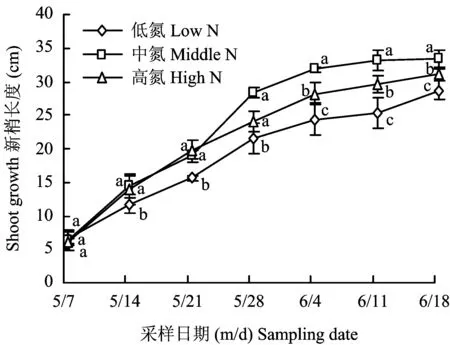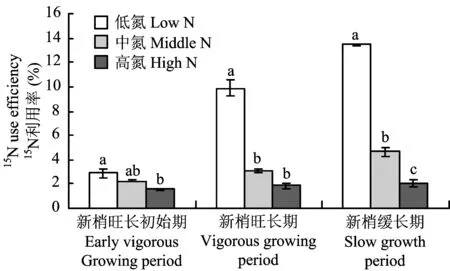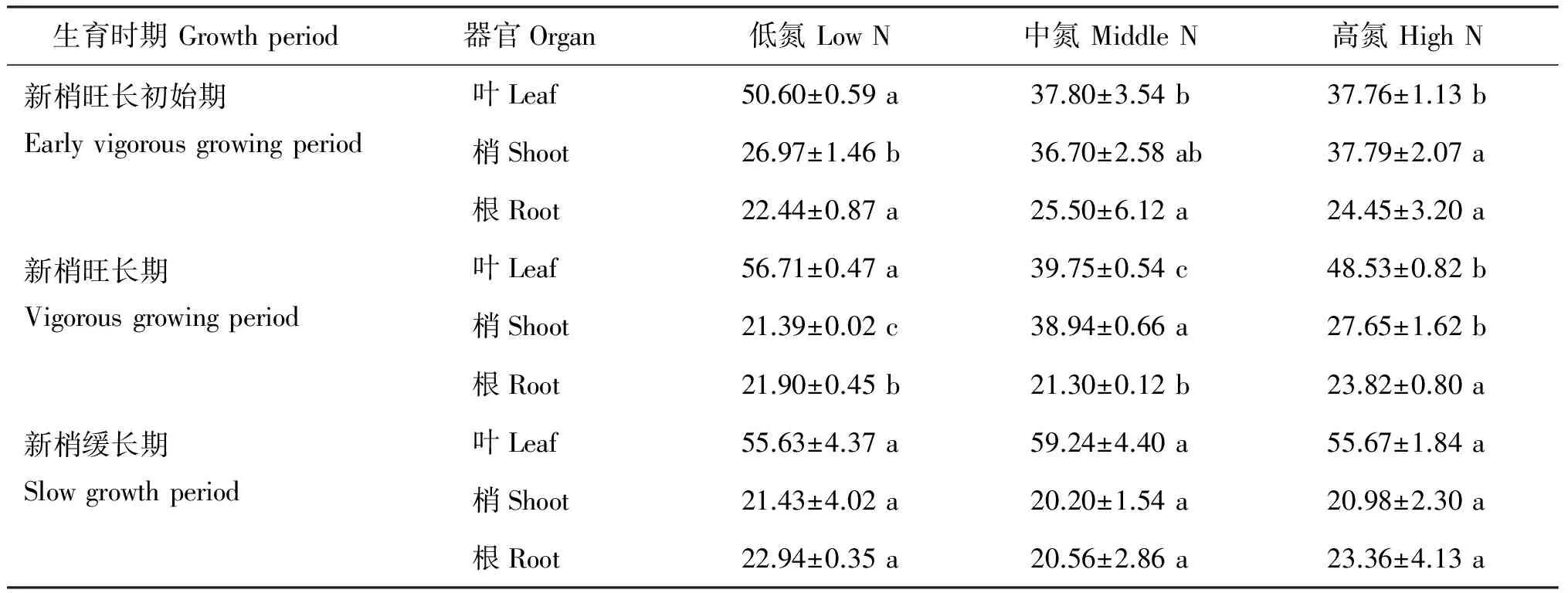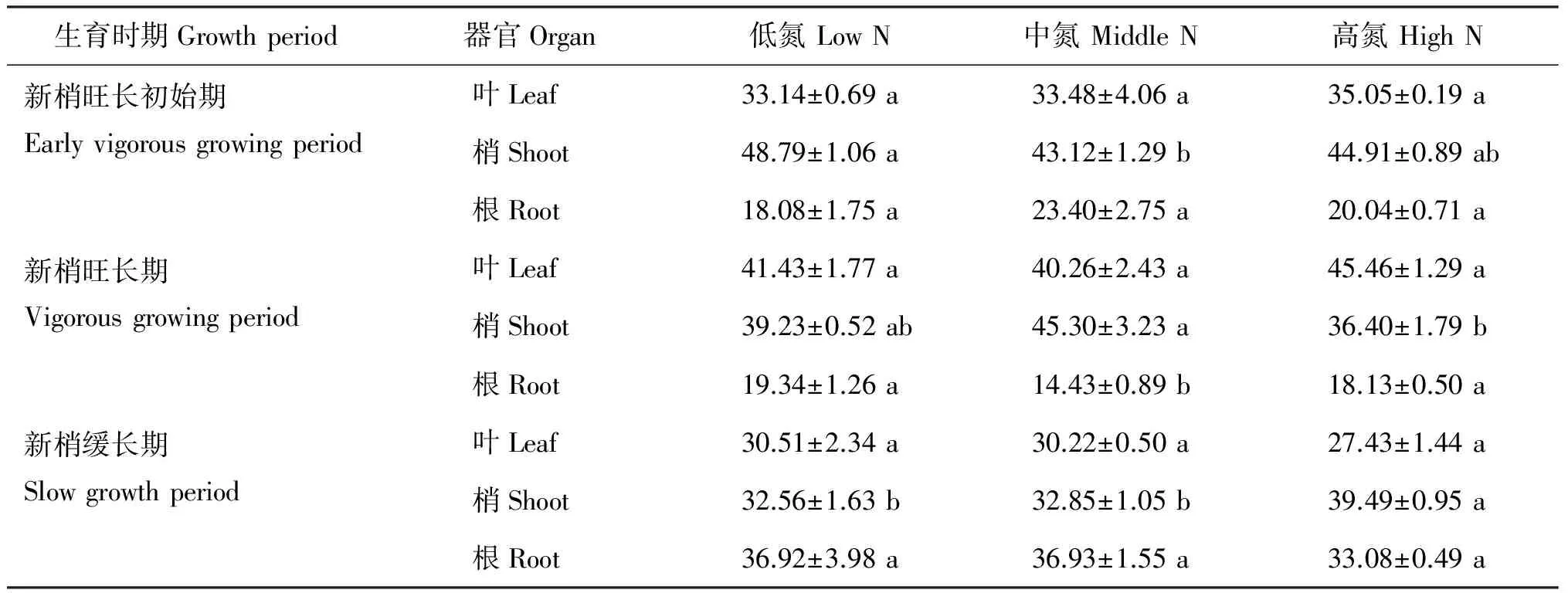施氮量对嘎啦幼苗15N、13C分配利用特性影响
孙聪伟, 褚凤杰, 杨丽丽, 陈 展, 姜远茂
(1 石家庄果树研究所, 河北石家庄 050061;2 作物生物学国家重点实验室, 山东农业大学园艺科学与工程学院, 山东泰安 271018)
施氮量对嘎啦幼苗15N、13C分配利用特性影响
孙聪伟1, 褚凤杰1, 杨丽丽1, 陈 展1, 姜远茂2*
(1 石家庄果树研究所, 河北石家庄 050061;2 作物生物学国家重点实验室, 山东农业大学园艺科学与工程学院, 山东泰安 271018)
【目的】采用15N、13C同位素示踪技术,通过对不同施氮量下嘎啦幼苗生长状况及氮、碳分配、利用特性等的研究,以期为苹果生产合理施肥提供依据。【方法】将2年生盆栽嘎啦幼苗进行低、中、高三个氮水平处理,同时进行15N标记。在新梢旺长初始期、新梢旺长期、新梢缓长期分别进行整株13C标记,72小时后,整株解析为叶、梢、根三部分,进行15N、13C测定。样品全氮用凯氏定氮法测定,15N丰度用ZHT-03质谱计测定。13C丰度用DELTA V Advantage同位素比率质谱仪测定。【结果】1)中、高氮水平的施肥处理可在不同程度上提高整株及叶片干物质量和新梢长度。新梢旺长初始期和新梢缓长期嘎啦幼苗整株干物质量、新梢旺长期叶片干物质分配比率在中、 高氮水平处理间差异不显著,中氮水平经济有效。新梢旺长期以后新梢长度以中氮>高氮>低氮,三者间差异性显著,中氮处理有利于新梢生长。2)在新梢旺长初始期,低氮处理植株叶片15N分配率达50%,比其他处理高出13个百分点左右,表明低氮处理更多的氮被叶片所利用,中氮和高氮处理间差异不显著,说明在本试验施氮条件下中氮供应水平已能满足氮素营养需求。3)新梢旺长期和新梢缓长期幼苗13C固定量均以中氮处理最高,新梢旺长初始期3个处理间根系13C分配率中氮>高氮>低氮,表明中氮处理有利于碳同化物在嘎啦幼苗中的分配。4)不同施氮量处理的嘎啦幼苗,15N利用率随施氮水平提高而降低,高氮处理对碳同化物分配没有显著贡献。【结论】低、中、高氮不同处理新梢缓长期碳同化物在各器官间的分配比较均衡,氮素水平不能影响碳同化物的分配。盆栽试验表明,中氮水平在保证营养供应的同时,能够促进新梢生长和树势健壮。
施氮量; 嘎啦;15N;13C; 分配; 利用
氮素供应影响果树的营养和生殖生长以及抗性、果实品质和储藏性状[1]。施肥不当,还会造成氮肥利用率降低[2-4],产量、品质下降[5],根系生长冗余[6],引起地下水污染[7]。
光合碳、氮代谢是植物体内最主要的两大代谢过程[8]。近年来在许多作物上应用稳定性同位素示踪技术进行了氮的吸收、运转、分配特性的研究[9-14],利用碳标记技术进行了光合产物去向的研究[15-18]。适量供氮促进光合产物的分配和运转[19-20]。高氮施用量可以减少麦类作物光合固定碳向地下碳库的转运,增加总碳量,过量氮则导致植物生长量下降[21]。目前不同施氮量对植物的影响研究主要集中在产量、氮素利用及平衡[2-3,22-23]等方面,而对于苹果不同时期氮、碳营养分配特性的影响报道较少,且多为对碳或氮的单独研究。本试验通过对不同施氮量下嘎啦幼苗生长状况,氮、碳营养分配等的研究,以期为苹果树合理施肥提供依据。
1 材料与方法
1.1 试验概况
盆栽试验在山东省泰安市黄家庄试验站进行。供试土壤为棕壤,碱解氮102.08 mg/kg、 速效磷50.73 mg/kg、 速效钾98.37 mg/kg、 有机质10.39 g/kg。于2011年3月20日将2年生嘎啦(Malusdomesticca)/八棱海棠(MalusmicromalusMakino)幼苗栽植于准备好的盆中,所用陶瓷盆内径25 cm、 高20 cm,每盆装土壤至盆沿3 cm处。
1.2 试验设计
树苗萌芽后选取长势一致、无病虫害的植株27棵,设三个氮水平处理,低氮不施尿素; 中氮施尿素1.6 g/pot,即32 g/m2; 高氮施尿素3.2 g/pot,即64 g/m2。各盆均匀施入(15NH2)2CO(丰度10.28%,上海化工研究院生产)0.3 g、磷酸氢二钙6.25 g、硫酸钾1.4 g,施肥后立即浇透水。
在新梢旺长初始期(5月7日)、新梢旺长期(5月28日)施用Ba13CO30.2 g/plant,在新梢缓长期(6月18日)施用Ba13CO30.6 g/plant进行13C气体标记[16, 24-25],各处理每个时期标记3株,单株重复3次,另取3株作为气体标记空白。72小时后破坏性取样,同时进行15N、13C测定。
1.3 测定方法与计算公式
整株解析为叶、梢、根三部分。样品按清水→洗涤剂→清水→1%盐酸→3次去离子水顺序冲洗后,105℃下杀青30 min置于80℃下烘干至恒重,粉碎后过0.147 mm筛,混匀后装袋备用。
样品全氮用凯氏定氮法测定[26];15N丰度用ZHT-03质谱计(在河北农林科学院遗传生理研究所)测定。
从氮肥中吸收的氮量(g)=器官全氮量(g)×植物样品中15N原子百分超%/肥料中15N原子百分超%
氮肥利用率(%)=从氮肥中吸收的氮量(g)/施氮量(g)×100
13C丰度用DELTA V Advantage同位素比率质谱仪(中国林科院稳定同位素实验室)测定。
Fi=(δ13C+1000)×RPBD/[(δ13C+1000)×RPBD+1000]×100
式中: Fi为13C丰度(%);RPDB为碳同位素的标准比值,RPDB=0.0112372。
进入各组分的13C量(mg):
13Ci= Ci×(Fi-F自然)×10
试验数据采用Microsoft Excel和DPS7.05进行统计分析,LSD法检验差异显著性。
2 结果与分析
2.1 不同施氮量对嘎啦幼苗生长动态的影响

注(Note): 同列数据后不同字母表示处理间差异达到5%显著水平 Values followed by different letters in a column are significant among the treatments at the 5% level.
2.1.2 不同施氮量对新梢生长动态的影响 如图1可以看到,不同施氮量嘎啦幼苗新梢的生长动态均呈单“S”曲线,低氮、中氮和高氮条件下幼苗新梢长度与天数的相关方程分别为: y=6.3936+0.8276x-0.00763x2,相关系数R2=0.9860;y=5.7842+1.3514x-0.0162x2,相关系数R2=0.9791;y=6.3250+1.1299x-0.0130x2, 相关系数R2=0.9988。表明氮肥水平增加有利于新梢生长。新梢旺长初始期,中、 高氮处理新梢长度显著高于低氮处理,但中、高氮处理间差异不显著。其他物候期新梢长度中氮>高氮>低氮,三者间差异性显著,表明中氮水平利于新梢生长。
2.2 不同施氮量对嘎啦幼苗15N吸收分配和利用的影响2.2.1 不同施氮量对15N利用率的影响 不同施氮量处理幼苗对15N-尿素的利用率均随物候期推移逐渐提高(图2)。新梢旺长初始期低氮、中氮、高氮条件下15N利用率分别为2.87%、 2.26%和1.55%,低氮和高氮处理间差异性显著。新梢旺长期低氮处理幼苗15N利用率大幅度提高(9.85%),显著大于其他处理,中、高氮处理间差异不显著。新梢缓长期3处理间15N利用率差异性显著,从高到低依次为低氮、中氮、高氮。其中高氮处理15N利用率一直处于低水平。

图1 不同施氮处理嘎啦幼苗新梢生长动态Fig.1 Shoot growth dynamics under different N treatments[注(Note): 不同字母表示处理间差异达到5%显著水平 Different letters in the same date are significant among the treatments at the 5% level.]
2.2.2 不同施氮量对各器官15N分配率的影响 由表2可知,新梢旺长初始期,不同施氮条件下幼苗根系15N分配率最低,其中低氮处理叶片15N分配率大于梢部,中、高氮处理叶片、梢部15N分配较均衡。不同施氮量处理对幼苗15N分配率的影响主要体现在地上部分。梢部15N分配率随施氮量增加而增大。叶片15N分配率低氮水平下显著高于其他处理,为50.60%,根系15N分配率最低,仅22.44%。这可能与低氮水平下氮素优先向新生器官运转有关。中、高氮处理间各器官15N分配率差异不显著。
新梢旺长期,植株新吸收的氮素主要分配供给新生器官形态建成,与新梢旺长初始期相比,不同处理幼苗分配到根系的15N-尿素减少,叶片15N分配率均有不同程度的提高,其中低氮处理叶片15N分配率仍然维持在极高水平(56.71%)。不同施氮水平下幼苗叶片15N分配率最高,低氮处理梢部最低;中、高氮处理根系最低。这是由于中氮处理地下部分氮素向地上运转,其他处理根、梢部氮素向叶片运转的结果。新梢旺长期为不同施氮量对幼苗各器官15N分配差异影响最大的时期。叶片15N分配率低氮>高氮>中氮,分别为56.71%,48.53%和39.75%。不同处理梢部15N分配率方向与叶片相反,这与中氮水平下新梢快速生长有利于激素、碳水化合物等生成有关。高氮处理根系15N分配率显著大于其他处理。

图2 不同施氮处理嘎啦幼苗不同物候期整株15N利用率Fig.2 15N utilization rate at different growth stages under different N treatments[注(Note): 柱上不同字母表示处理间差异达到5%显著水平 Different letters above the bars are significant among the treatments at the 5% level.]

表2 不同施氮处理嘎啦幼苗各器官 15N分配率(%)
注(Note): 同行数据后不同字母表示同一器官不同处理间差异达到5%显著水平 Values followed by different letters in a row are significant in the same organ among the treatments at the 5% level.
新梢缓长期,随着氮素的不停运转,各处理间植株各器官15N分配状况趋于一致。其中低氮处理幼苗各器官15N分配表现出与新梢旺长期一致的趋势。还可以看出低氮水平下幼苗15N运转主要在新梢旺长期以前,梢部和根系15N急剧向叶片运输,可见新生器官对氮素的需求一直处于高水平。中氮条件下新梢旺长期氮素由地下部向地上部运转,新梢缓长期大量氮素继续向叶片富集。高氮水平下梢、根部氮素逐步向叶片运转。
2.3 不同施氮量对嘎啦幼苗13C同化物积累和分配的影响
2.3.1 不同施氮量对13C固定量的影响 图3可见,不同处理幼苗13C固定量变化呈现出相似的规律,新梢旺长初始期最低,随叶片生长和光合作用增强,13C固定量不断增加,至新梢缓长期达最高。其中施氮量对新梢旺长期幼苗13C固定量影响较大,低氮处理显著低于其他处理,中、高氮处理间差异不显著。新梢缓长期13C固定量中氮、低氮、高氮依次为8.10、 6.78、 6.48 mg/plant,新梢旺长期和新梢缓长期均以中氮处理下13C固定量最高,表明中氮处理13C固定量优于其他处理。

图3 不同施氮处理嘎啦幼苗不同物候期整株13C固定量Fig.3 Amounts of 13C assimilation at different growth stages under different treatments[注(Note): 柱上不同字母表示处理间差异达到5%显著水平 Different letters above the bars are significant among the treatments at the 5% level.]
2.3.2 不同施氮量对各器官13C分配率的影响 如表3所示,新梢旺长初始期,各处理幼苗13C分配率均以梢部最高,根系最低。不同处理叶片13C分配率随氮素水平增高而上升。施氮量对碳同化物分配的影响主要在梢部,低氮处理显著大于中氮处理。根系13C分配率与梢部相反为中氮>高氮>低氮,表明中氮处理有利于幼苗碳同化物向根系分配。

表3 不同处理各器官13C分配率(%)
注(Note): 同行数据后不同字母表示同一器官不同处理间差异达到5%显著水平 Values followed by different letters in a row are significant in the same organ among the treatments at the 5% level.
新梢旺长期,随新梢发育叶片大量生长,叶片碳同化物自留量较新梢旺长初始期显著提高,其中高氮处理增长更为明显。中氮处理梢部13C分配率最高,根系最低;其他处理叶片最高,根系最低。不同施氮处理幼苗叶片碳同化物分配率差异不显著。中氮处理根系碳同化物分配率显著低于其他处理,而梢部碳同化物分配率中氮>低氮>高氮,分别为45.30%、39.23%和36.40%。这与此时期中氮处理新梢生长量远大于低、高氮处理有关。
新梢缓长期,随新梢生长速度放缓,光合产物在叶片及地上部的分配减少,大量同化物向根系转移。不同处理幼苗碳同化物在各器官间的分配差异趋于一致。梢部13C分配率高氮处理显著大于其他处理,低氮与中氮间差异不显著。
3 讨论与结论
本试验结果表明进行中、高氮水平的施肥处理可在不同程度上提高整株及叶片干物质、新梢长度。其中新梢旺长初始期和新梢缓长期嘎啦幼苗整株干物质、新梢旺长期叶片干物质分配比率中、高氮水平间差异不显著,可见中氮经济有效。新梢旺长期以后新梢长度中氮>高氮>低氮,三者间差异性显著,表明中氮处理促进新梢生长。
土壤氮的供应是植物碳、氮积累与分配的主要影响因素之一[27]。春季施15N-尿素后,叶片和新梢中15N分配率迅速上升,促进营养生长,这与赵林等[14]的实验结果一致。氮素作为可再利用元素优先向新生器官运转,低氮处理植株仅施入15N-尿素0.3 g,相对于中氮和高氮水平来说供氮量很低,叶片15N分配率却达50%,比其他处理高出13个百分点左右,这表明低氮处理不能满足植株生长的需要;中氮和高氮处理间差异不显著,15N利用率随施氮量增加而降低,说明在本试验施氮条件下中氮供应水平已能满足氮素营养需求。新梢旺长期和新梢缓长期幼苗13C固定量均以中氮处理最高,新梢旺长初始期3个处理间根系13C分配率为中氮>高氮>低氮,表明中氮处理有利于碳同化物在嘎啦幼苗中的分配。
苹果植株的氮素营养可分为3个时期[28]。从新梢旺长初始期到新梢旺长期,为大量需氮期。本研究15N和13C双示踪试验结果表明,新梢旺长期梢部15N分配率中氮、高氮、低氮间差异性显著,分别为38.94%、 27.65%、 21.39%。低氮处理氮素较多地向叶片富集,高氮处理氮素较多地向根系分配,中氮处理叶片、根系15N分配率均处于低水平。碳同化物分配表现出与氮素分配一致的趋势,中氮处理叶片合成大量碳同化物主要分配在梢部(45.30%),根系分配率反而不及其他处理,一方面避开了根系冗余,一方面削弱了植株极性生长。
碳素同化物的分配主要是随生长中心的转移而发生变化的[29]。新梢旺长期碳同化物的分配中心为新梢和叶片,新梢缓长期叶片库强和库活性减弱,碳同化物在各器官间的分配比较均衡[30]。低、中、高氮不同处理均遵循这一规律。可见氮素水平不能影响碳同化物的分配。这与隋方功等[8]在甜椒上的实验结果一致。
不同施氮量处理的嘎啦幼苗,15N利用率随施氮水平提高而降低,高氮处理对13C固定量及碳同化物分配没有显著贡献。盆栽试验表明中氮水平在保证营养供应的同时,能够促进新梢生长和树势健壮。 本试验结果在田间生产上的应用有待进一步研究。
[1] 李文庆, 张民, 束怀瑞. 氮素在果树上的生理作用[J]. 山东农业大学学报(自然科学版), 2002, 33(1): 96-100. Li W Q, Zhang M, Shu H R. The physiological effects of nitrogen on fruit trees[J]. Journal of Shandong Agricultural University (Natural Science), 2002, 33(1): 96-100.
[2] 葛顺峰, 姜远茂, 魏绍冲, 房祥吉. 不同供氮水平下幼龄苹果园氮素去向初探[J]. 植物营养与肥料学报, 2011, 17(4): 949- 955. Ge S F, Jiang Y M, Wei S C,Fang X J. Nitrogen balance under different nitrogen application rates in young apple orchards[J]. Plant Nutrition and Fertilizer Science, 2011, 17(4): 949-955.
[3] 张爱平, 杨世琦, 杨淑静, 等. 不同供氮水平对春小麦产量、氮肥利用率及氮平衡的影响[J]. 中国农学通报, 2009, 25(17): 137-142. Zhang A P, Yang S Q, Yang S Jetal. Effect of N rates on yield of spring wheat, fertilizer N recovery and N balance[J]. Chinese Agricultural Science Bulletin, 2009, 25(17): 137-142.
[4] 易镇邪, 王璞, 陈平平, 屠乃美. 氮肥类型对夏玉米氮素吸收和利用的影响[J]. 植物营养与肥料学报, 2008, 14(3): 472-478. Yi Z X, Wang P, Chen P P, Tu N M. Effect of different types of nitrogen fertilizer on nitrogen absorption and utilization of summer maize[J]. Plant Nutrition and Fertilizer Science, 2008, 14(3): 472-478.
[5] Weaver M A L. Changing farm practice to meet environmental objectives of nutrient loss to Oyster Harbour[J]. Fertilizer Research, 1993, 36: 177-184.
[6] 胡艳丽, 毛志泉, 沈向, 等. 不同施肥水平对苹果砧木根冠发育的影响[J]. 山东农业大学学报(自然科学版), 2010, 41(1): 51-56. Hu Y L, Mao Z Q, Shen Xetal. The effects on root and shoot of apples stocks development with different fertility level[J]. Journal of Shandong Agricultural University (Natural Science), 2010, 41(1): 51-56.
[7] 范可正. 中国肥料手册[M]. 北京: 中国化工信息中心, 2001. Fan K Z. China fertilizer manual[M]. Beijing: China National Chemical Information Center, 2001.
[8] 隋方功, 王运华. 植物碳素营养研究中碳同位素示踪技术的应用及进展[J]. 莱阳农学院学报, 2001, 18(2): 107-111. Sui F G, Wang Y H. Application and progress of carbon isotope tracer technique of carbon nutrition in plants[J]. Journal of Laiyang Agricultural College, 2001, 18(2): 107-111.
[9] 龚振平, 金喜军, 马春梅, 张磊. 春大豆对不同来源氮素吸收利用的研究[J]. 土壤通报, 2010, 41(5): 1138-1141. Gong Z P, Jin X J, Ma C M, Zhang L. Study on the absorption and utilization of various source nitrogen by spring soybean[J]. Chinese Journal of Soil Science, 2010, 41(5): 1138-1141.
[10] 郭英燕, 姜远茂, 彭福田. 保护地草莓不同追肥时期15N吸收利用特点初探[J]. 园艺学报, 2003, 30(5): 574-576. Guo Y Y, Jiang Y M, Peng F T. Studies on the15N absorption and utilization characteristics of strawberry in different N application stage[J]. Acta Horticulturae Sinica, 2003, 30(5): 574-576.
[11] 赵登超, 姜远茂, 彭福田, 等. 冬枣秋季不同枝条叶施15N-尿素的贮藏、分配及再利用[J]. 核农学报, 2007, 21(1): 87-90. Zhao D C, Jiang Y M, Peng F Tetal. Nitrogen storage and distribution and reuse of15N-urea applied in autumn on different branch leaves of winter jujube (ZizyphusjujubaMill. var. inermis Rehd) trees[J]. Journal of Nuclear Agricultural Sciences, 2007, 21(1): 87-90.
[12] 史祥宾, 杨阳, 翟衡, 等. 不同时期施用氮肥对巨峰葡萄氮素吸收、分配及利用的影响[J]. 植物营养与肥料学报, 2011, 17(6): 1444-1450. Shi X B, Yang Y, Zhai Hetal. Effects of N fertilization on nitrogen absorption, distribution and utilization of Kyoho grape[J]. Plant Nutrition and Fertilizer Science, 2011, 17(6): 1444-1450.
[13] 葛顺峰, 赵凤霞, 姜远茂, 等. 土施和枝干涂抹15N-尿素对氮素在甜樱桃树不同部位分配及利用的影响[J]. 植物营养与肥料学报, 2011, 17(1): 254-258. Ge S F, Zhao F X, Jiang Y Metal. Effect of15N daubing and soil fertilizations on distribution and utilization of urea in different parts of sweet-cherry[J]. Plant Nutrition and Fertilizer Science, 2011, 17(1): 254-258.
[14] 赵林, 姜远茂, 彭福田, 等. 嘎拉苹果对春施15N-尿素的吸收、利用与分配特性[J]. 植物营养与肥料学报, 2009, 15(6): 1439-1443. Zhao L, Jiang Y M, Peng F Tetal. Characteristics in the absorption, utilization and distribution of spring soil15N-urea application for Gala/Malus hupehensis[J]. Plant Nutrition and Fertilizer Science, 2009, 15(6): 1439-1443.
[15] 齐鑫, 王敬国. 应用13C脉冲标记方法研究不同施氮量对冬小麦净光合碳分配及其向地下输入的影响[J]. 农业环境科学学报, 2008, 27(6): 2524-2530. Qi X, Wang J G. Distribution and translocation of assimilated C pulse-labeled with13C for winter wheat (TrticumaestivumsL.), as affected by nitrogen supply[J]. Journal of Agro-Environment Science, 2008, 27(6): 2524 - 2530.
[16] 何敏毅, 孟凡乔, 史雅娟, 吴文良. 用13C 脉冲标记法研究玉米光合碳分配及其向地下的输入[J]. 环境科学, 2008, 29(2): 446-453. He M Y, Meng F Q, Shi Y J, Wu W L. Estimating photosynthesized carbon distribution and inputs into belowground in a maize soil following13C pulse-labeling[J]. Environmental Science, 2008, 29(2): 446-453.
[17] 范爽, 高东升, 韩红霞. 设施栽培中桃树14C同化物分配特性的研究[J]. 园艺学报, 2006, 33(5): 1067-1070. Fan S, Gao D S, Han H X. Studies on the characteristics of distribution of14C-assimilates in peach under protected culture[J]. Acta Horticulturae Sinica, 2006, 33(5): 1067-1070.
[18] 李利红, 马锋旺, 白静, 李玲. 杏花芽分化后期碳素同化物的分配[J]. 果树学报, 2004, 21(1): 73-75. Li L H, Ma F W, Bai J, Li L. Studies on the distribution of carbon assimilation in different apricot varieties during flower bud differentiation[J]. Journal of Fruit Science, 2004, 21(1): 73-75.
[19] 王磊, 姜远茂, 彭福田, 等. 主枝开张角度对盆栽红富士苹果13C和15N分配、利用的影响[J]. 植物营养与肥料学报, 2011, 17(2): 433-437. Wang L, Jiang Y M, Peng F Tetal. Effects of main-branch bending on characteristics of distribution and utilization of13C and15N for Red Fuji[J]. Plant Nutrition and Fertilizer Science, 2011, 17(2): 433-437.
[20] 隋方功, 吕银燕, 王运华, 等. 不同施氮量对甜椒碳、氮营养分配的影响[J]. 园艺学报, 2004, 31(4): 472-476. Sui F G, Lü Y Y, Wang Y Hetal. Effect of different nitrogen rates on the distribution of carbon and nitrogen in sweet pepper[J]. Acta Horticulturae Sinica, 2004, 31(4): 472-476.
[21] Kuzyakov Y, Domanski G. Carbon input by plants into the soils review[J]. Journal of Plant Nutrition and Soil Science, 2000, 163: 421-431.
[22] 席瑞卿, 赵晓进, 张考学, 等. 不同施肥水平对苹果产量、品质及养分平衡的影响[J]. 西北农业学报, 2010, 19(2): 141-145. Xi R Q, Zhao X J, Zhang K Xetal. Effect of different fertilizing level on yield and quality and nutrient equilibrium of apple[J]. Acta Agriculturae Boreali-occidentalis Sinica, 2010, 19(2): 141-145.
[23] 赵满兴, 周建斌, 杨绒, 等. 不同施氮量对旱地不同品种冬小麦氮素累积、运输和分配的影响[J]. 植物营养与肥料学报, 2006, 12(2): 143- 149. Zhao M X, Zhou J B, Yang Retal. Characteristics of nitrogen accumulation, distribution and translocation in winter wheat on dryland[J]. Plant Nutrition and Fertilizer Science, 2006, 12(2): 143- 149.
[24] 沈其荣, 殷士学, 杨超光, 陈巍.13C标记技术在土壤和植物营养研究中的应用[J]. 植物营养与肥料学报, 2000, 6(1): 98-105. Shen Q R, Yin S X, Yang C G, Chen W. Aplication of13C labeling technique to soil science and plant nutrition[J]. Plant Nutrition and Fertilizer Science, 2000, 6(1): 98-105.
[25] Lu Y H, Watanabe A, Kimura M. Input and distribution of photosyn-thesized carbon in a flooded soil[J]. Global Biogeochem Cycles, 2002, 16: 321-328.
[26] 鲍士旦. 土壤农化分析(第三版)[M]. 北京: 中国农业出版社, 2000. 263-268. Bao S D. Analysis of soil and agrochemistry[M]. Beijing: China Agricultural Press, 2000. 263-268.
[27] 陈安磊, 谢小立, 文菀玉, 等. 长期施肥对红壤稻田氮储量的影响[J]. 生态学报, 2010, 30(18): 5059-5065. Chen A L, Xie X L, Wen W Yetal. Effect of long term fertilization on soil profile nitrogen storage in a reddish paddy soil[J]. Acta Ecologica Sinica, 2010, 30(18): 5059-5065.
[28] 顾曼如, 张若杼, 束怀瑞, 等. 苹果氮素营养研究初报—植株中氮素营养的年周期变化特性[J]. 园艺学报, 1981, 8(4): 21- 28. Gu M R, Zhang R Z, Shu H Retal. A study on the nitrogen nutrition of apple tree—The variation of nitrogen nutrition within the plant in a year’s cycle[J]. Acta Horticulturae Sinica, 1981, 8(4): 21-28.
[29] 王仲春. 苹果幼树碳素同化物运转特性研究Ⅰ.周年运转特性[J]. 山东农业大学学报, 1986, 17(2): 43-53. Wang Z C. Studies on the translocation characteristics of carbon assimilates in young apple treesⅠ. The characteristics of annual translocation[J]. Journal of Shandong Agricultural University, 1986, 17(2): 43-53.
[30] 丁平海, 王中英. 不同物候期苹果体内碳同化物的分配规律[J]. 河北农业大学学报, 1997, 3: 52-57. Ding P H, Wang Z Y. The allocation patterns of carbon assimilates in apple tree of different phonological period[J]. Journal of Agricultural University of Hebei, 1997, 3: 52-57.
Effects of nitrogen fertilization on characteristics of distribution and utilization of15N and13C of Gala seedlings
SUN Cong-wei1, CHU Feng-jie1, YANG Li-li1, CHEN Zhan1, JIANG Yuan-mao2*
(1ShijiazhuangPomologyInstitute,Shijiazhuang050061,China; 2StateKeyLaboratoryofCropBiology/CollegeofHorticultureScienceandEngineering,ShandongAgriculturalUniversity,Tai’an,Shandong271018,China)
【Objectives】 Nitrogen fertilizer has stimulative effect on fruit tree growth, but the effect is different. Studying the allocation of nitrogen nutrition and photosynthetic products has important significance on guiding rational use of nitrogen fertilizer. This experiment studied characteristics of distribution and utilization of15N and13C in potted Gala seedlings under different nitrogen levels in order to provide the basis for rational fertilization.【Methods】 Two-year Gala(Malusdomesticca)/Malus robusta(MalusmicromalusMakino) seedlings were treated with three nitrogen levels: low, middle and high nitrogen, and 0.3 g(15NH2)2CO was used evenly as a marker. The13CO2was used as a gas marker at the early vigorous growing period, vigorous growing period and slow growth period of shoots. After 72 hours, the whole plants were divided into leaves, shoots and roots for analysis. The total nitrogen content was detected by the micro-kjeldahl method. The15N abundance was detected by ZHT-03 mass spectrometer. The13C abundance was detected by DELTA V Advantage isotope ratio mass spectrometer. 【Results】 The middle and high nitrogen levels improve the dry matter accumulation of leaves, stems and the whole plant in different degrees. There are no significant differences in plant dry biomasses between the middle and high nitrogen treatments at the early vigorous growing period and slow growth period of shoots, nor the dry biomass of leaves between the middle and high nitrogen treatments at the vigorous growing period. After the vigorous growing period, the shoot lengths are in order of middle >high>low N treament, and the differences among them are quite remarkable. The middle nitrogen level is beneficial to shoot growth. Under low nitrogen treatment in early vigorous growing period, as high as 50% of the15N is distributed in leaves, which is 13 percentage points higher than those of the middle and high N treatments, indicating the less transform of nitrogen from leaves to other organs in low nitrogen treatment. The ratios of the15N distributed in leaves are not statistically significant between the middle and high N treatments, so the middle nitrogen supply can meet the demand of plant to nitrogen in this study. The13C assimilation capacity of the middle nitrogen treatment is the highest at the vigorous growing period and slow growth period of shoots. The order of the13C distribution ratios in roots under different N levels is middle>high >low at the early vigorous growing period, which shows that the middle level of nitrogen treatment is beneficial to carbon assimilate distribution. The15N utilization rates decrease with the nitrogen level increase, and the high nitrogen treatment does not significantly affect the distribution of assimilated carbon.【Conclusions】 Different nitrogen levels have no obviously impact on the distribution of assimilated carbon. The middle level of nitrogen fertilization can satisfy the N nutrition requirement, and benefit shoots growth and tree vigour.
N level; Gala;15N;13C; distribution; utilization
2014-01-08 接受日期: 2014-04-02
现代农业产业技术体系建设专项资金(CARS-28);公益性行业(农业)科研专项资金(201103003);山东省农业重大应用创新课题(201009)资助。
孙聪伟(1987—),女,河北石家庄人,硕士,主要从事果树营养生理研究。E-mail: suncongwei-ok@163.com * 通信作者 E-mail: ymjiang@sdau.edu.cn
S147.22; S661.1
A
1008-505X(2015)02-0431-08

